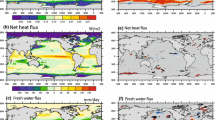Abstract
Asynchronous and periodically-synchronous schemes for coupling atmosphere and ocean models are presented. The performance of the schemes is tested by simulating the climatic response to a step function forcing and to a gradually increasing forcing with a simple zero-dimensional non-linear energy balance model. Both the initial transient response and the asymptotic approach of the equilibrium state are studied. If no annual cycle is allowed the asynchronous coupling technique proves to be a suitable tool. However, if the annual cycle is retained, the periodically synchronous coupling technique reproduces the results of the synchronously coupled runs with smaller bias. In this case it is important that the total length of one synchronous period and one ocean only period is not a multiple of 6 months.
Similar content being viewed by others
References
Cubasch U, Hasselmann K, Höck H, Maier-Reimer E, Mikolajewicz U, Santer BD, Sausen R (1992) Time-dependent greenhouse warming computations with a coupled ocean-atmosphere model. Clim Dyn 8:55–69
Cubasch U, Santer BD, Hellbach A, Hegerl G, Höck H, Maier-Reimer E, Mikolajewicz U, Stössel A, Voss R (1994) Monte Carlo climate change forecasts with a global coupled oceanatmosphere model. Clim Dyn 10:1–19
Dickinson RE (1981) Convergence rate and stability of oceanatmosphere coupling schemes with a zero-dimensional climate model. J Atmos Sci 38:2112–2121
Harvey LDD (1986) Computational efficiency and accuracy of methods for asynchronously coupling atmosphere-ocean models. Part II: testing with a seasonal cycle. J Phys Oceanogr 16:11–24
Houghton JT, Jenkins GJ, Ephraums JJ (eds) (1990) Climate change: the IPCC scientific assessment. Cambridge University Press, Cambridge, UK
Lunkeit F, Sausen R, Oberhuber JM (1996) Climate simulations with the global coupled atmosphere-ocean model ECHAM2/ OPYC. Part I: present-day climate and ENSO events. Clim Dyn 12:195–212
Manabe S, Bryan K (1969) Climate calculations with a combined ocean-atmosphere model. J Atm Sci 26:786–789
Manabe S, Bryan K, Spelman MJ (1979) A global ocean atmosphere climate model with seasonal variation for future studies of the climate system. Dyn Atmos Oceans 3:393–426
Manabe S, Stouffer RJ (1988) Two stable equilibria of a coupled ocean-atmosphere model. J Clim 1:841–866
Manabe S, Stouffer RJ, Spelman MJ, Bryan K (1991) Transient response of a coupled ocean-atmosphere model to gradual changes of atmospheric CO2. Part I: annual mean response. J Clim 4:785–818
Manabe S, Stouffer RJ (1994) Multiple-century response of a coupled ocean-atmosphere model to an increase of the atmospheric carbon dioxide. J Clim 7:5–23
Murphy JM (1995) Transient response of the Hadley centre coupled ocean-atmosphere model to increasing carbon dioxide. Part I: control climate and flux adjustment. J Clim 8:36–56
North GR, Cahalan RF, Coakley JA (1981) Energy balance climate models. Rev Geophys Space Phys 19:91–121
Roberts DL (1990) An investigation of the Gates asynchronous coupling strategy using a simple energy-balance model. Dyn Atmos Oceans 14:279–301
Sausen R (1988) Asynchronous coupling of ocean and atmosphere models. In: Modelling the sensitivity and variations of the ocean-atmosphere system. Rep Workshop at ECMWF. WCRP-15, WMO/TD-No. 254:280–289
Sausen R, Lunkeit F (1990) Some remarks on the cause of the climate drift of coupled ocean-atmosphere models. Beitr Phys Atmosph 63:141–146
Schlesinger ME (1979) Discussion of “A global ocean-atmosphere model with seasonal variation for future studies of climate sensitivity”. Dyn Atmos Oceans 3:427–432
Schneider SH, Harvey LDD (1986) Computational efficiency and accuracy of methods for asynchronously coupling atmosphere-ocean models. Part I: testing with a mean annual model. J Phys Oceanogr 16:3–10
von Storch J-S (1994) Interdecadal variability in a global coupled model. Tellus 46A:419–432
Voss R, Sausen R (1996) Techniques for asynchronous and periodically synchronous coupling of atmosphere and ocean models. Part 11: impact of variability. Climate Dynamics (in press)
Washington WM, Semtner AJ, Meehl GA, Knight DJ, Mayer TA (1980) A general circulation experiment with a coupled atmosphere, ocean and sea ice model. J Phys Oceanogr 10:1887–1908
Washington WM, Meehl GA (1989) Climate sensitivity due to increased CO2 experiments with a coupled atmosphere and ocean general circulation model. Clim Dyn 4:1–38
Author information
Authors and Affiliations
Rights and permissions
About this article
Cite this article
Sausen, R., Voss, R. Techniques for asynchronous and periodically synchronous coupling of atmosphere and ocean models. Climate Dynamics 12, 313–323 (1996). https://doi.org/10.1007/BF00231105
Received:
Accepted:
Issue Date:
DOI: https://doi.org/10.1007/BF00231105




